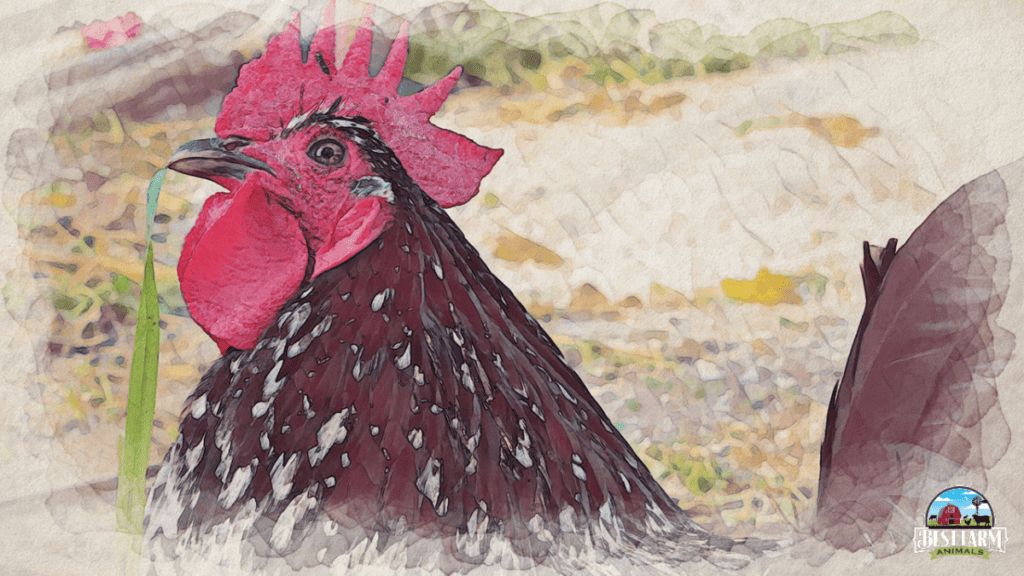This medium-sized chicken hails from the city of Ancona in Central Italy and is one of the best egg layer breeds in the world. They were imported to England in 1850. After that, they became a prime egg breed across Europe. They are very flighty and often considered wild. That’s because they like to roost in trees and love to fly.
What Does An Ancona Look Like?
The Ancona is a black bird with white-tipped feathers. It has a black mottled with white coloring. One in three feathers has a white tip. The white feathering increases every time the bird molts.
Black feathers have a green sheen to them. They also have yellow legs with black mottle down them. Hens have a medium comb with five points, while roosters have a single large comb. They have orange-red eyes, white earlobes, and white skin.
Anconas are sometimes called a black Leghorn, although that is an incorrect description. Anconas have backs that slant downward. Plus, they didn’t originate from the same breeds of chickens and Leghorns.
Ancona was admitted to the American Poultry Association in 1898 with a single comb variety. Rose comb varieties were admitted in 1914. They have a natural lifespan of about 8 years. Ancona chickens are a heritage chicken.
Are Ancona Chickens Good Egg Layers?
When it comes to egg production capabilities, Ancona chickens are in a league of their own.
Ancona chickens are extremely good egg layers. These birds can lay anywhere between 220-300 large and white eggs annually, an impressive feat by any standards! Perhaps what’s most remarkable about this breed is that they lay more in winter than Leghorns do – an average of about five to six eggs weekly!
Remarkably these birds start laying at only five months old! Another notable aspect about Anconas is that they lay many white eggs throughout the year and have traditionally been bred for both meat and egg purposes – though now it’s mainly for the latter.

Caring For Your Ancona: Are Ancona Chickens Winter Hardy?
Ancona chickens do very well in in the winter’s temperature extremes. They are extremely winter hardy. They often don’t care what type of climate they are in- they are healthy and happy in any environment! They are great birds for hot climates and for cold climates. They even love extremely hot temperatures!
They are friendly and often popular for a backyard bird, but they are also very flighty. They can escape backyards very well. They will need some extra attention and effort to keep them contained.
Anconas are also one of the most intelligent of the chicken varieties. They sense danger better than other varieties.They do very good in a free-range situation and will forage well. They also have a lower food to egg ratio.
They do very well in cold situations. They can be flighty and a little wild-like in their behavior.
They are a “watch” breed according to the Livestock Conservatory list, which means they aren’t rare but do have an estimated population of fewer than 10,000 birds worldwide.
Anacondas are also a heritage breed.
| Climate | Personality | Use | Size | Eggs/ Yr | Brooder | Forages |
| Hot & Cold | FriendlyFlighty | Eggs | F: 4.5 lbsM: 6 lbs | 220-300 | No | Yes |
Anconas are typically not available at local farm supply stores. You can order them online from several hatcheries around the United States. In Europe, they are most often found in England and Italy.
- Very Predator Aware
- Very Cold Tolerant
- Strong Egg Layer
My Favorite Chicken and Duck Supplies
This list contains affiliate products. Affiliate products do not cost more but helps to support BestFarmAnimals and our goal to provide farm animal owners with accurate and helpful information.
Manna Pro Oyster Shell keeps eggs strong. Before I gave my chickens oyster shell, I had the oddest eggs, many with weak and irregular shells. Now, I don’t have an issue.
Layer Feed by Manna Pro. I like pellets rather than crumbles as my chickens eat them better and less gets wasted or scavenged by rodents. A good layer feed makes the difference in hens laying many more eggs.
My chickens love this mealworm treat, which gives added protein, something that’s great during molting and winter months.
There are many ways to feed and water your chickens. I like this food and water setup the best because it reduces waste, saves me time feeding and watering, and keeps the food fresh longer. Except, in the winter, I use a heated waterer. The only problem is the heated waterers need to be replaced every few years.
I love this chicken veggie hanger. It makes it easy to give your chickens produce from the garden and keep them occupied in the winter with a fresh head of lettuce.
These chicken toys are a hoot! They will help curb bullying and keep your chickens active, especially in the winter when hens tend to get more lethargic.

